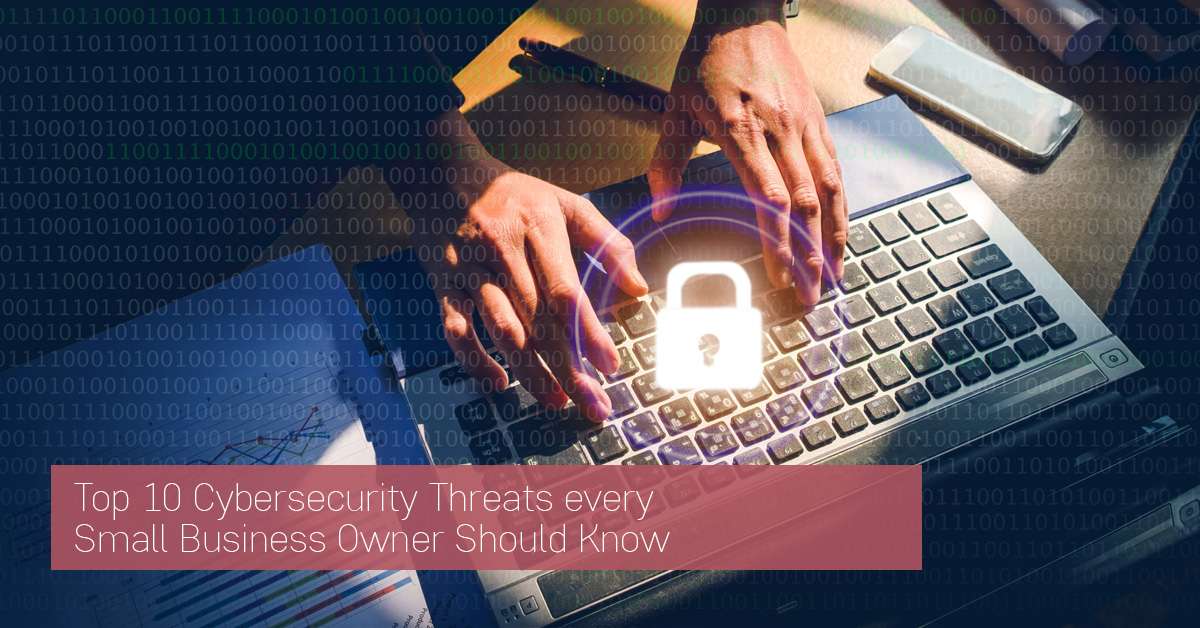The continued rise of cybercrime and the devastating effects it has on small businesses has become a pandemic in its own right. According to a study by Cybersecurity Ventures, cyber threats will cost the global economy $6 trillion annually by 2021. While companies are starting to understand the risks, hackers and cybercriminals are showing no signs of slowing down their attacks. For small business owners, a cyberattack could pose an existential threat to their company.
10 Newly Emerging Threat Vectors Business Owners Should Consider
Malware infections can spread through networks while remaining undetected, allowing bad actors to wait for the perfect moment to strike. Hackers either focus on extracting sensitive information from the company networks or, in the case of ransomware, hold the entire IT system hostage by crippling its business operations.
While prevention is still important, business resilience and recovery planning should also be a priority. The evolving risk management techniques now place both approaches on equal standing, showing that the likelihood of a successful attack has increased exponentially over the past few years. Here are 10 emerging threat vectors that every business owner should know about and plan for in 2020.
1. Deepfakes
The possibilities that Artificial Intelligence (AI) brings to the world of technology is revolutionary. One way bad actors and cybercriminals are using this technology is to generate deepfakes. The term originates from deep learning and fake, with the technology capable of generating video and audio content that could be indistinguishable from authentic material.
Hackers are using machine learning (ML) and AI to produce synthetic human videos or audio material to impersonate and coerce individuals. Deepfake attacks partnered with business email compromise (BEC) techniques have led to hackers eliciting fraudulent money transfers from companies.
2. Synthetic Identities
Criminals can create synthetic identities by combining real credentials with fabricated references that make it difficult to determine a communication’s authenticity. Hackers will use selected information, like a legitimate physical address partnered with a fake Social Security Number (SSN) and birthdate, to defraud organizations.
3. Endpoint Security for Remote Workers
More companies will have to depend on a remote workforce in the future, extending the threat perimeter of their critical business systems. It’s common for remote workers to use their home Wi-Fi connections and mobile devices when accessing the company’s network. Organizations will need to include these environments in their cybersecurity planning, as WatchGuard predicts 25% of all cyber breaches will involve an off-premises asset, mobile device, or telecommuter’s infrastructure in 2020.
4. Cloud Jacking
While cloud system deployments provide many benefits for companies, it could also expose them to cloud jacking. Cloud platforms can be vulnerable to misconfiguration, injection attacks, and cross-site scripting. As these systems depend on emerging technologies like serverless code, containerization, and third-party libraries, hackers are working to develop attack techniques for each of these elements.
5. Internet of Things (IoT) Device Hacking
Every connected device can become an entry point into a company’s network. While printers were a regular target in the past, today hackers look for sensors, cameras, access control scanners, or smart displays to exploit. Businesses that use IoT devices in their operations will need to increase their cybersecurity and scrutinize these systems as part of their threat landscape.
6. More Sophisticated Ransomware
Ransomware attacks have become one of the biggest threats every business faces today. The effects of a single successful ransomware attack can devastate business operations, and analysts predict that malware-as-a-service will become more sophisticated in 2020. Ransomware kits are already cheap and readily available on the dark web, which will lead to an increase in these types of attacks on businesses of every size.
7. 5G to Wi-Fi Cybersecurity Vulnerabilities
Rolling out 5G networks will require carriers to hand off more calls and data to Wi-Fi networks, creating a vulnerability in the process. A cybersecurity skills gap will compound the issue, but the silent switching between network types in backend processes on devices will become an attractive attack point for cybercriminals.
8. BYOD and Mobile Malware
Allowing staff to use their own devices for work purposes can improve efficiency, but hackers know that these are easy targets for deploying an exploit into a corporate network. Cybercriminals now develop attacks that target most of the mobile operating systems, giving them access to a user’s phone or tablet. When the device connects to the company’s network, the infection can spread to other systems.
9. Insider Threats
Negligence and malicious attacks that originate from trusted sources inside the network contributed to 34% of cyber breaches in 2019. Detecting insider threats is difficult due to the privileges granted to users while performing their normal duties. To protect against insider threats, businesses will need to monitor user behavior and alert security teams of any anomalous actions detected.
10. Increase in Phishing Attempts
Phishing remains the number one concern for businesses, as it is still a stalwart in a hacker’s toolbox. Spear-phishing will utilize the capabilities of AI, ML, and deepfakes to plan a successful attack. Keeping employees educated about the risks and having a recovery plan in place can help companies combat the increased threats posed by phishing attacks.
Protecting Your Company Against New Threats with Cartridge World Quad Cities
Cybersecurity will need a renewed focus from all organizations going forward. To improve the protection of your network perimeter, you’ll need access to technical experts who are dedicated to both preventing and recovering from an attack. Cartridge World Quad Cities help businesses to establish effective network security on devices, including the company’s print fleet. To find out how Cartridge World Quad Cities can help you weather the coming cybersecurity storm, contact us for a free assessment today.
